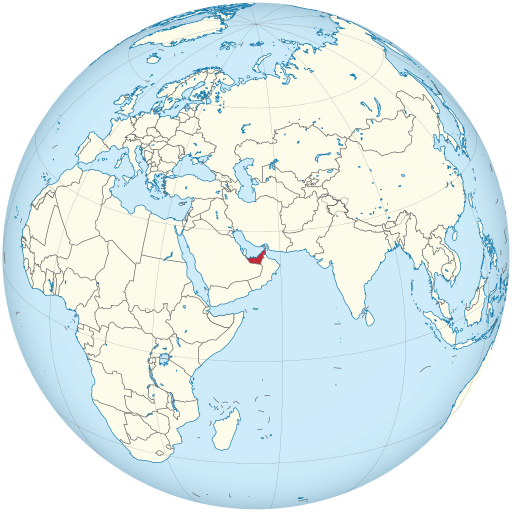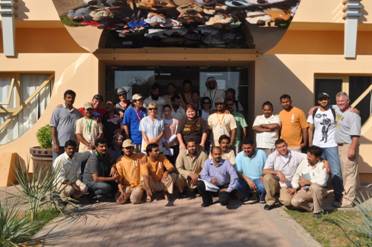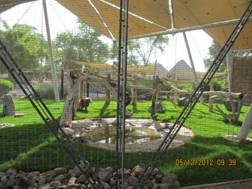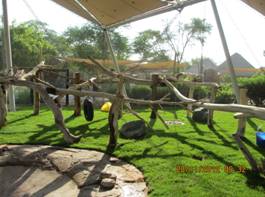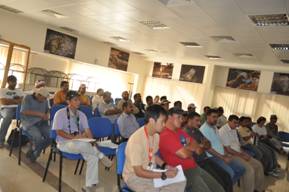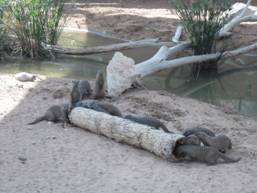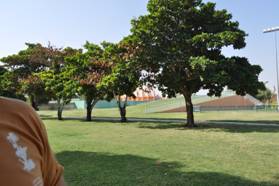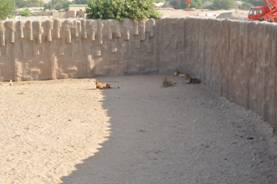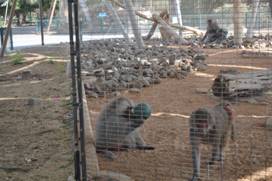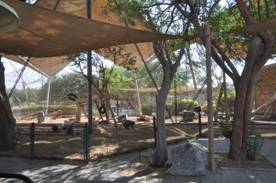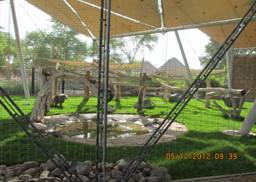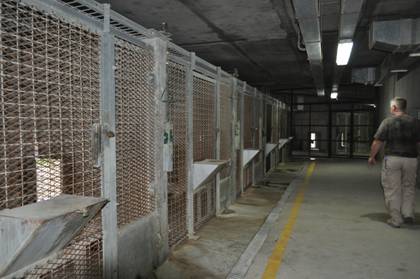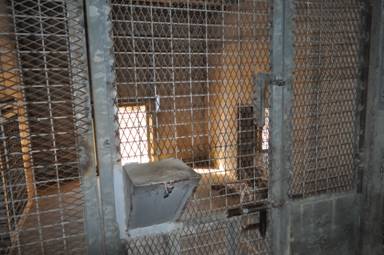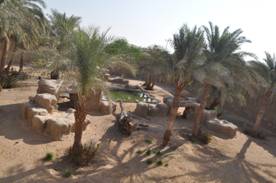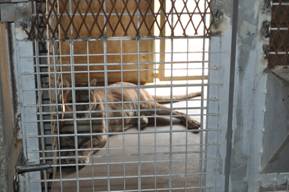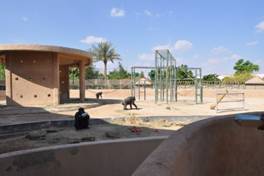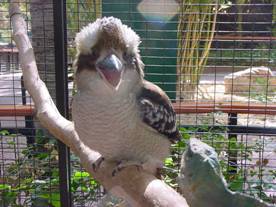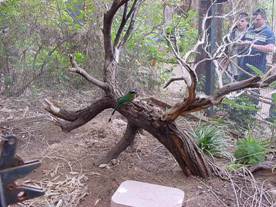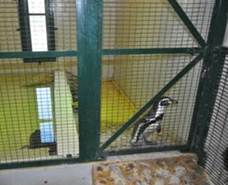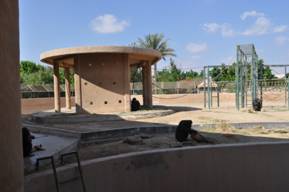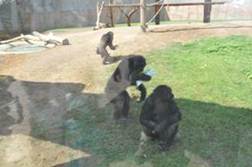
|
Hilda Tresz Global Volunteer Work | |||||||||
|
|
United Arab Emirates Al Ain Zoo Report | ||||||||
|
10/28/2012
–11/1/2012 Goals The
purpose of the visit was to create an overall assessment of the Al
Ain Zoo’s facilities in relation to behavioral enrichment, and
to provide suggestions for improvements.
Water supply,
water conservation and enrichment The
zoo has beautiful, large exhibits for most of the animals. Some of
these enclosures contain over-sized ponds.
Baboon exhibit
with large water pond
Pond
drained to increase floor space and decrease water usage Suggestions:
For those species that do not use them, these ponds could be
drained and automatic waterers can be installed instead. Please
review information regarding Lixit Automatic Dog Waterer for
Outdoor Faucets & Spigots http://www.gundogsupply.com/-l100-.htm
<http://www.gundogsupply.com/-l100-.htm>
The
drains can be secured, covered and ponds could be filled with
substrate. This could be a crucial step towards: 1.
Conserving
water 2.
Redirecting
water supply for irrigation for future browse gardens and grass in
exhibits 3.
Gaining
larger floor space in exhibits 4. Saving
considerable time, manpower and cleaning supply The
management agreed that it was an idea they would indeed like to
consider. Browse
and browse gardens The
Phoenix Zoo’s “Beneficial Browse” presentation was given to
show how gardens can be created in similar climates to that of the
Sonoran Desert environment. The presentation was also provided in
Arabic. The Zoo has
immediately started to work on providing browse and other plant
materials for the animals. The mongooses are already receiving
palm (see photograph).
Additionally the
following information was provided: 1. Approved browse proposals by
taxa 2. Approved herbs and spices
proposals by taxa 3. Browse list and delivery
system schedule for all species at the Phoenix Zoo 4. Information
of Curator of Horticulture and BE Representative for further
communications if more details are required Suggestions;
In order to provide fresh leafy branches to all species possible,
browse gardens can be created. There are not enough browseable
trees on zoo grounds to sustain the collection’s needs.
·
Lucerne
Alfalfa (Medicago sativa). Fresh Lucerne is very good
substitute for trees and leafy branches due to its highly
digestible fiber. Although, it is suggested not to be given every
day and in high amounts due to its high protein content. This
plant could be given to all primates and carnivores as well as to
birds in suggested amounts as browse, substate or manipulanda
detemined by the veterinarian.
·
Farms and
plantations. Building relationships with surrounding
establishments all over in Al Ain that have access to plants being
disposed regularly. These plants (if they are not sprayed with
pesticides) could be regularly picked up and distributed to all
animals needed. It would also create a good relationship between
the zoo and the plantations.
·
Only edible
trees planted in and around exhibits. Geographically fitting,
edible trees could be planted into each exhibit and along visitor
pathways in abundance that would provide shade and food in a few
years as well as making the zoo more pleasing for the human eye.
·
Browse
gardens could be established all over on zoo grounds. Since most
of the trees will not geographically fit into the landscape, these
gardens could be established either out of visitor’s view, or
explained by signs for the visitors abut their purpose.
Grass in
exhibits
The visitors
do not seem to utilize most of the luscious, green areas.
Suggestions:
Due to year around high temperature it would be beneficial to grow
grass in animal exhibits instead to provide:
1.
Temperature
control (grass itself decreases exhibit temperatures by 10-15 F)
2.
Nutritional
supplement and foraging opportunities
3.
Behavioral
enrichment
4.
Medical
aid (soft surface to prevent possible foot problems)
5.
Naturalistic
exhibits
For the visitors long pathways surrounded with acacia and mesquite
tress that require less water but could provide luxurious shaded
areas
Substrate use
and Contra freeloading (Foraging enrichment) Both
presentations were given to staff. The Contra freeloading
presentation was available in both Arabic and English. The
Substrate presentation is currently being translated. Timothy
hay was placed for substrates and some browse for foraging and
nest building into all primate exhibits. Please review animals
being active and busy foraging through substrate on the picture
below.
Exhibit
with rocks and soil
Same
exhibit with hay or sod. All animals are peacefully foraging
Suggestions: Continue keeping animals off of hard/ cold/ wet/ dry,
unyielding surfaces (concrete, tile, wood floor, etc.). It will
make a significant difference not only to the animals’ health
but also to improve the aesthetics of the exhibits. It was
suggested to purchase Bermuda hay- due to Timothy hay being more
expensive.
Carnivore
night house areas need the most attention in regards to substrate.
Due to having only one exhibit for a large number of animals (even
if the animals are rotated) the animals hardly have any time to be
outside. These animals are kept on the bare surface with almost no
furniture or substrate and without objects to manipulate. These
animals need toys/foraging devices such as boomer balls with dry
food, jungle balls, logs to tear apart and browse, cardboard
boxes, etc., to play with. In order to maintain the enrichment
program of such large amount of carnivores, it is suggested to
increase the number of staff as well as to change to work hours
from 8AM-12PM and 3AM-6PM to a continuous full eight hour work
from 7AM to 4PM.
Another
easy way to provide enrichment would be to switch different
species to different exhibits such as moving the white tiger into
the puma exhibit providing a much larger pool and different
environment. Additional
carnivore enrichment ideas: http://www.ottoenvironmental.com/shopexd.asp?id=6815&bid=False Breeding/Inbreeding
and Euthanasia Even
if the carnivores or any other species kept inside were provided
with the best enrichment programs possible, the problem of
rotating such a large collection of animals (to enjoy fresh air,
sunshine, rain, soil, etc.) would remain. While exhibit animals
are kept in large, luxurious exhibits, the rest of the
over-populated collection is being held inside in small, empty
cages. Some of these animals (mostly lions) in my understanding
are inbred to the point of being born without their legs or
without paws in order to reach more popular colors.
Suggestions:
Extensive breeding could be prevented by euthanizing all animals
that are inbred or whose quality of life is poor and placing the
rest of the animals under birth control. Once the collection
becomes a manageable size, inbreeding can be avoided by tracking
down information of the animals’ origin. If information is not
available, DNA exams can verify which individuals can be bred with
whom. Exhibit
furniture and 3 Dimensions In
some of the exhibits/displays (especially carnivore night houses)
animals can only (or mostly) use floor space.
Suggestion:
To further improve quality, permanent and flexible furniture needs
to be installed to each cage. Animals need both in order to
develop/exhibit proper motor skills. Night houses, sleeping
quarters, animal holding pens should utilize three dimensions by
adding large tree trunks, ropes, fire hoses, hammocks, wooden
shelves, etc., to increase space and opportunities to the animals
for exercise, exploration and manipulation.
Outside furniture needs to be built from wood, ropes or any kind
of natural materials as opposed to metal and recycled plastic.
Flexible furniture could be attached by clips and carabineers and
the ropes’ locations moved periodically (such as clipping ropes
from one direction to another) so enrichment would not become
enhancement. Birds in the
Back of House These
animals are kept in a rather small area in large numbers with
inadequate perching and without sunshine. Suggestions:
The diameters of the perches are so big that the birds’ feet
need to be stretched out at all times. This may cause tendon and
joint problems or possible bumble foot in the future. Natural tree
perches with a large variety of diameters would be more feasible.
Please see example pictures from the Phoenix Zoos’ browse
presentation:
Inadequate
large diameter perch vs. large variety of perches with different
diameters A
reduction in the number of birds would be also beneficial. Tortoises Next to this
bird area BOH there were some tortoises in a fairly large exhibit.
Suggestions: These animals could use a large mud pile (besides
their pool) to provide better skin care, protection from the sun
and also temperature regulation (allow them to cool off in the
summer heat). Also, if food were scattered, the animals could
forage for longer time.
Porcupine Suggestions: The porcupine needs to be moved out of the reptile house and into an outside mixed exhibit as the animal does not get to be seen nor does he get any natural sunlight.
Social enrichment
Very
impressively, only few primates were kept in solitary confinement
due to preventing inbreeding or because the animals did not get
along. As there is no
hope to receive another gorilla (Gorilla gorilla gorilla) for the lone female whose mate
died, there are not many options for her. She had a rabbit as her
companion. She also received a stuffed toy to play with. The rest
of the animals (patas monkeys (Erythrocebus patas); vervet
monkeys (Chlorocebus pygerythrus) and White handed gibbon (Hylobates
lar) were immediately moved and/or accessed next to each other
to have direct tactile, visual or olfactory contact with
conspecifics. Soft, introductions were started and will continue
by the Primate Manager. Suggestion:
Until the females’ birth control starts working, animals can be
rotated in a way of keeping father-son inside while having the
female outside (gibbons) or letting the male stay with one female
inside while the second is on exhibit but accessed next to them (Patas)
etc. Also, sick animals that are highly social can be paired up
with a companion animal with veterinarian approval to decrease
stress level.
Chimpanzees Again,
impressively (compared to so many zoos) I found all chimpanzees in
group settings. Group 4 was exhibited behind the scenes while
Group 3 was visible for the public.
Suggestions:
Since the animals are in small groups and Group 3’s exhibit is
much larger with green grass as well; it would be desirable if
these animals could be introduced to each other. The management
was also considering renovating and connecting all for enclosures
of the old exhibit and house the chimpanzees there eventually.
Please let me know if we can move forward in developing a
comprehensive introduction plan to improve the welfare of captive
chimpanzees.
All chimpanzees need to receive milk, yogurt and hard
boiled eggs for protein. They could also receive herbal tea. General
enrichment The zoo just has
started its enrichment program. It is laudable that a permanent
Nutrition
& Enrichment Section Head
position
was established to oversee the program and even more commendable
that the new c Section
Head was already traveling
to see other zoos’ enrichment programs and brought
in a consultant to gain additional insight. Enrichment
scheduling and basic documentation was started on hard copies and
will be transferred in the future to computers. However, most of
the workers (with the exception to the management staff) are not
computer literate and some of them cannot read or write, so the
process could take a while. In order to help
improving current program the following documentations were
provided: ·
Enrichment monthly schedules ·
Enrichment evaluation
templates with rating scales ·
Articles and power point
presentations regarding enrichment ideas, establishing enrichment
programs, involving the community and incorporating behavioral
enrichment into every day management. ·
Information about
establishing and managing a Behavioral Enrichment Committee
including enrichment and training representative job descriptions
·
Training 101 in-house school
class for beginner trainers |
| Program
Information |
| Research Password
Required
|
|
Education Instruction Manuals ChimpanZoo Data System Guide
|
| Enrichment |
Contact Information
ChimpanZoo
the Jane Goodall Institute
| Global
BWB Secretarial Limited
10 Queen Street Place
London, EC4R 1BE
United Kingdom
